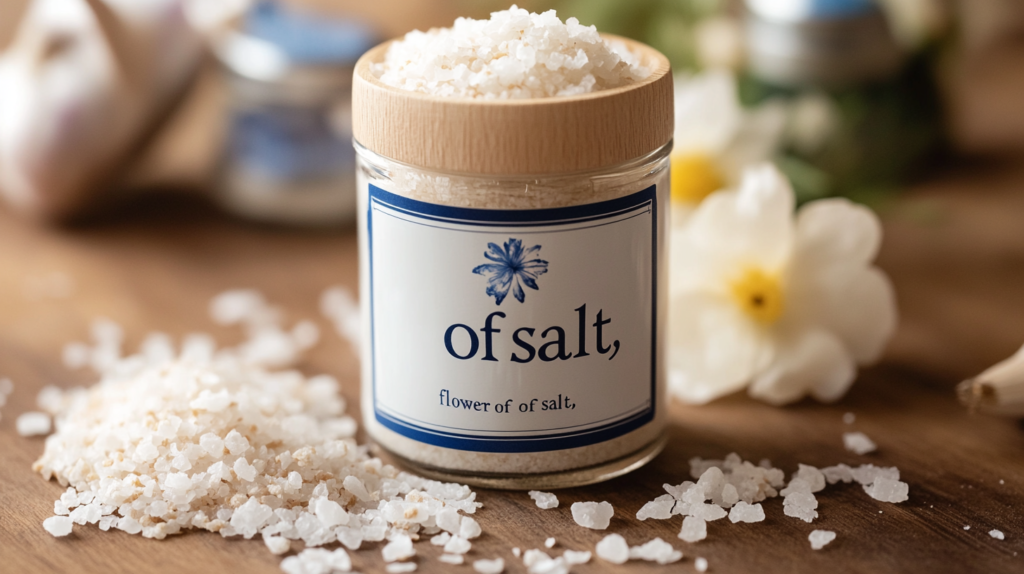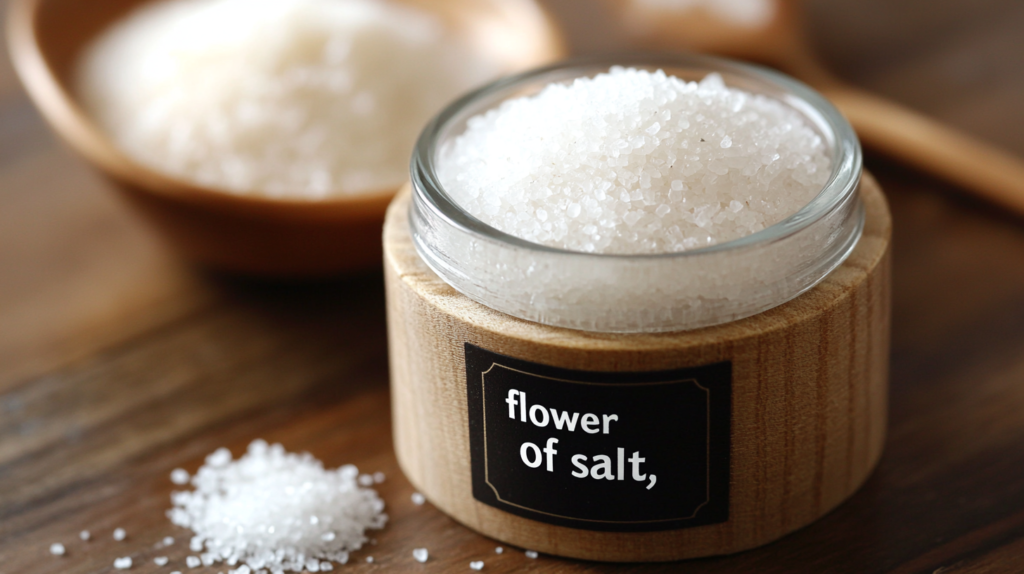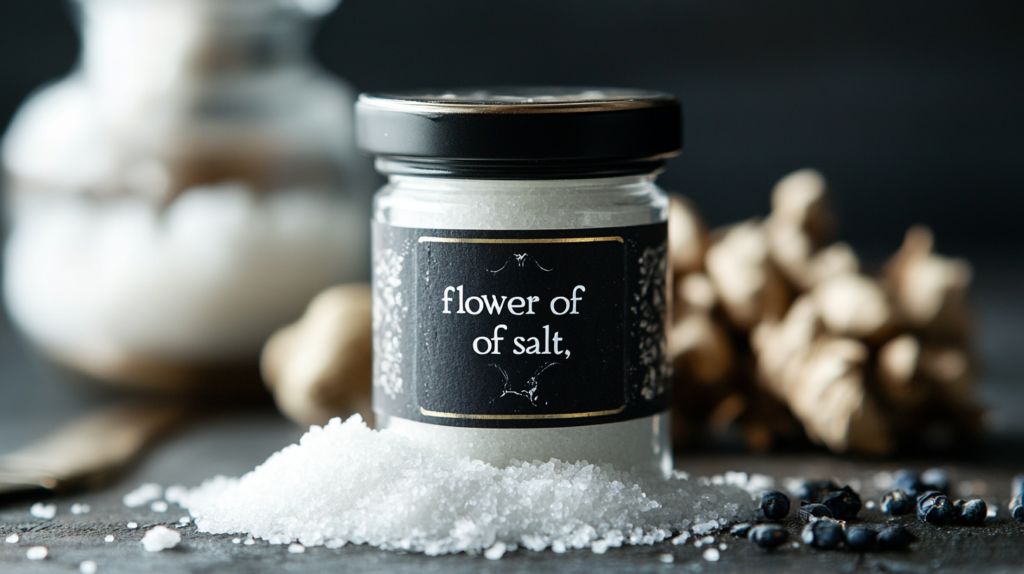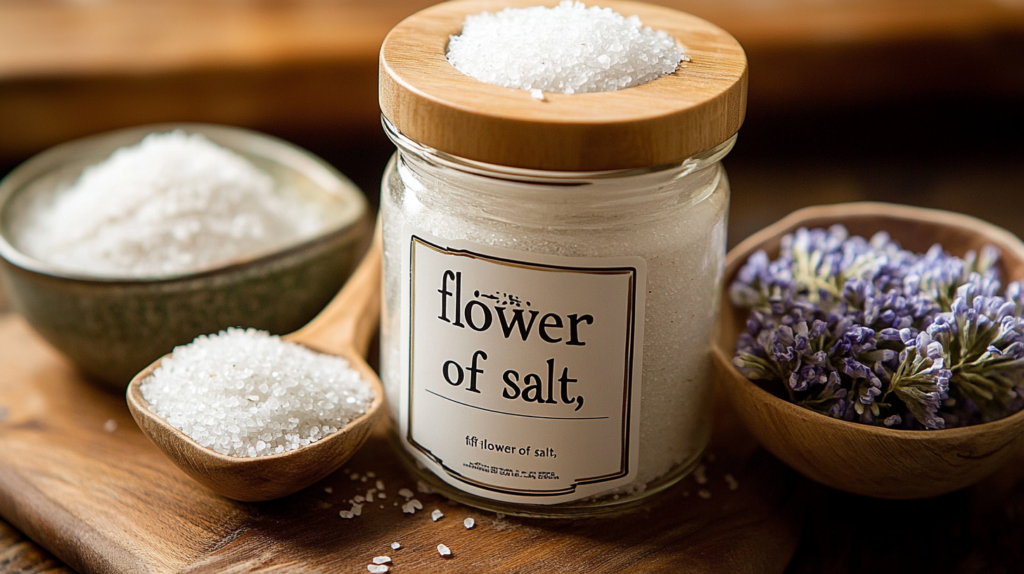What is Fleur de Sel?
Fleur de Sel, which translates to “flower of salt,” is a delicate and highly prized finishing salt known for its subtle flavor and crunchy texture. Harvested by hand from salt ponds, this artisanal salt is celebrated for enhancing the flavor of both sweet and savory dishes.
Definition and Meaning
Fleur de Sell refers to the thin, flaky salt crystals that form naturally on the surface of seawater as it evaporates:
- Appearance: It has a light, flaky texture and an off-white or pale gray color due to the presence of natural minerals.
- Taste: Fleur de Sell is less salty than regular table salt, offering a more nuanced and complex flavor.
- Usage: Primarily used as a finishing salt, it adds a subtle crunch and enhances the natural flavors of dishes without overpowering them.
History and Origins
Fleur de Sel has a long history and is deeply rooted in coastal salt-making traditions:
- Origins: It is believed to have been first harvested in France, particularly in the Guérande region, over 1,000 years ago. The tradition continues today, with Guérande Fleur de Sell being one of the most famous varieties.
- Harvesting Process: The salt is collected by skilled salt farmers, or “paludiers,” who carefully skim the delicate salt crystals from the surface of the salt ponds on warm, sunny days.
- Global Recognition: While traditionally associated with France, Fleur de Sell is now also harvested in other coastal regions, including Portugal, Spain, and Canada, each offering unique characteristics based on local environmental conditions.
How Fleur de Sel Differs from Regular Salt
Fleur de Sell stands out from regular salt due to its unique qualities and harvesting process:
- Texture and Appearance:
- Fleur de Sel: Flaky, delicate crystals with a natural grayish tint.
- Regular Salt: Fine-grained and uniform, often processed to remove impurities.
- Flavor Profile:
- Fleur de Sel: Subtle, less salty, and rich in minerals, which contribute to its complex taste.
- Regular Salt: Intense, sharp saltiness with no additional flavor nuances.
- Production Method:
- Fleur de Sel: Harvested by hand using traditional techniques, making it more labor-intensive and exclusive.
- Regular Salt: Produced on an industrial scale, often refined and stripped of minerals.
- Usage:
- Fleur de Sel: Used as a finishing salt to sprinkle on dishes just before serving, enhancing texture and flavor.
- Regular Salt: Primarily used in cooking or as a seasoning during food preparation.
Fleur de Sell is a luxurious and natural seasoning that elevates culinary creations with its delicate flavor and artisanal origins. Its rich history, unique texture, and versatility make it a must-have for chefs and food enthusiasts alike.

How Fleur de Sell is Harvested
The harvesting of Fleur de Sell is a meticulous and traditional process that highlights its artisanal nature. From extraction techniques to the regions that produce it, every detail contributes to the unique quality of this prized finishing salt.
Traditional Methods of Extraction
Fleur de Sell is collected using age-old techniques that prioritize quality and craftsmanship:
- Salt Ponds:
- Seawater is guided into shallow, clay-lined salt ponds, where it evaporates under the sun and wind, leaving behind salt crystals.
- Skimming the Surface:
- On warm, sunny days with light winds, a thin layer of salt crystals forms on the water’s surface.
- Skilled salt farmers, or “paludiers,” gently skim these delicate crystals using wooden tools like rakes to avoid disturbing the underlying salt.
- Drying and Packaging:
- The harvested Fleur de Sel is air-dried naturally to retain its moisture and mineral-rich properties.
- It is then hand-packaged to preserve its flaky texture and artisanal quality.
This careful process ensures that Fleur de Sell maintains its unique flavor and texture, distinguishing it from other salts.
Regions Known for Producing Fleur de Sel
Fleur de Sell is harvested in specific coastal areas where the environmental conditions are ideal:
- Guérande, France:
- Guérande, often regarded as the birthplace of Fleur de Sel, produces high-quality salt using centuries-old harvesting methods.
- Camarque, France:
- Located in southern France, this region produces Fleur de Sel with a slightly different mineral composition due to its unique marine environment.
- Portugal:
- The Algarve region is famous for its artisanal Fleur de Sel, prized for its purity and delicate flavor.
- Spain:
- Coastal areas like Mallorca produce Fleur de Sel with a distinct character shaped by the Mediterranean climate.
- Canada:
- Nova Scotia’s Fleur de Sel reflects the cool Atlantic waters, offering a unique flavor profile.
Each region’s environment and traditional methods contribute to the subtle variations in flavor and texture.
Seasonal and Environmental Factors
The production of Fleur de Sel is highly dependent on natural conditions:
- Seasonality:
- The best harvests occur during summer months when consistent sun and gentle breezes promote evaporation and crystal formation.
- Weather:
- Too much wind or rain can disrupt the delicate crystals or wash them away, making harvesting impossible.
- Climate:
- Coastal regions with clean seawater and unpolluted air produce the highest quality Fleur de Sel.
- Sustainability:
- Traditional harvesting methods prioritize environmental harmony, ensuring the long-term preservation of salt ponds and their ecosystems.
Fleur de Sel’s harvesting process reflects a harmonious blend of natural elements and human expertise. Its regional distinctions and artisanal production make it a treasured seasoning, perfect for enhancing any culinary creation.

Characteristics of Fleur de Sell
Fleur de Sell is celebrated for its exceptional qualities, making it a sought-after finishing salt in culinary circles. Its texture, flavor, and unique properties distinguish it from other salts, elevating dishes with a touch of sophistication.
Texture and Appearance
Fleur de Sell has a distinctive texture and visual appeal:
- Delicate Flakes:
- It forms as light, flaky crystals that easily crumble between your fingers, making it perfect for sprinkling over dishes.
- Moisture Content:
- Unlike dry table salt, Fleur de Sel retains a slight moisture due to its artisanal harvesting process, which enhances its stickiness and flavor delivery.
- Color:
- Fleur de Sel typically displays an off-white or pale gray hue, resulting from the natural minerals in the seawater used during harvesting.
This texture and appearance not only add a unique tactile element but also contribute to its visual appeal when used as a garnish.
Flavor Profile and Unique Qualities
Fleur de Sel offers a more nuanced flavor compared to regular salt:
- Mild Saltiness:
- It provides a gentle, less intense saltiness, allowing the flavors of other ingredients to shine.
- Complex Notes:
- The trace minerals, such as magnesium and calcium, give Fleur de Sel a subtle complexity and depth that enhances both savory and sweet dishes.
- Crunch Factor:
- Its delicate crunch adds a textural contrast to dishes, making every bite more interesting.
These qualities make Fleur de Sell a favorite among chefs and home cooks who value its ability to subtly elevate flavors without overwhelming them.
Comparison to Other Gourmet Salts
Fleur de Sell stands out even among other high-quality salts:
- Fleur de Sell vs. Maldon Salt:
- Texture: Both have flaky textures, but Fleur de Sel is slightly moister, while Maldon salt is drier and crisper.
- Flavor: Fleur de Sel has a more mineral-forward taste, while Maldon salt is milder and less complex.
- Fleur de Sel vs. Himalayan Pink Salt:
- Texture: Himalayan salt is typically coarse or fine-grained, unlike the delicate flakes of Fleur de Sel.
- Flavor: Himalayan salt has a more robust, earthy flavor due to its higher mineral content, making it better suited for cooking rather than finishing.
- Fleur de Sell vs. Kosher Salt:
- Kosher salt works best for cooking and seasoning because of its larger crystals and easy dissolution, while Fleur de Sel serves exclusively as a finishing salt.
- Flavor: Kosher salt lacks the nuanced flavor profile and mineral richness of Fleur de Sel.
Fleur de Sel’s delicate texture, nuanced flavor, and artisanal qualities make it an unparalleled choice for finishing dishes. Its ability to enhance the taste and presentation of food with a subtle elegance has earned it a place in the kitchens of culinary enthusiasts worldwide.
Nutritional Value and Benefits
Fleur de Sell offers exceptional flavor, texture, and nutritional benefits. Packed with trace minerals, it provides a nuanced way to season dishes, making it a premium finishing salt that enhances both health and taste when used mindfully.
Trace Minerals in Fleur de Sell
Fleur de Sell retains natural trace minerals due to its artisanal harvesting process:
- Magnesium:
- Contributes to muscle function, nerve health, and energy production.
- Calcium:
- Essential for bone health and the proper functioning of the heart and muscles.
- Potassium:
- Helps regulate fluid balance, muscle contractions, and nerve signals.
- Iron:
- Plays a role in oxygen transport and the production of red blood cells.
These minerals give Fleur de Sell its distinctive flavor and make it a more nutrient-rich option compared to refined salts, which are stripped of their natural components.
How It Enhances Flavors
Fleur de Sel excels in enhancing flavors without overpowering them:
- Balanced Saltiness:
- Its mild saltiness allows the natural flavors of ingredients to shine while adding depth.
- Flavor Delivery:
- The slight moisture content and flaky texture allow it to dissolve slowly, providing bursts of flavor with every bite.
- Versatile Use:
- Ideal for finishing dishes, it complements both savory and sweet creations, such as roasted vegetables, grilled meats, chocolates, and caramels.
By using Fleur de Sell sparingly as a finishing touch, you can elevate the taste of your dishes without adding excessive sodium.
Potential Health Benefits of Moderate Use
While salt consumption should always be moderated, Fleur de Sell offers unique benefits when used appropriately:
- Lower Sodium Per Volume:
- Its flaky texture means you use less by volume compared to denser salts like table salt, helping reduce overall sodium intake.
- Mineral Content:
- The trace minerals in Fleur de Sel provide small but beneficial contributions to your diet, supporting overall health.
- Mindful Eating:
- Because Fleur de Sel is used as a finishing salt, it encourages mindful seasoning, helping you appreciate the natural flavors of food without over-salting.
Important Note: While Fleur de Sell contains trace minerals, it is not a significant source of nutrients. It should be used in moderation as part of a balanced diet.

Fleur de Sell is a flavorful and nutrient-rich salt that enhances dishes while offering a touch of trace minerals. Used thoughtfully, it can contribute to both the enjoyment and nutritional value of your meals, making it a worthwhile addition to any kitchen.
Frequently Asked Questions About Fleur de Sel
Fleur de Sell is a unique and versatile finishing salt that often raises questions about its uses, benefits, and availability. Here are answers to some common queries.
What is Fleur de Sell?
Fleur de Sell, or “flower of salt,” is a delicate, flaky salt harvested from the surface of seawater in salt ponds.Fleur de Sell offers mild saltiness, a mineral-rich flavor, and a slightly moist texture, making it ideal as a finishing salt to enhance the taste of dishes.
What is Fleur de Sel Salt?
Fleur de Sell salt refers to the same product—artisanal sea salt collected using traditional methods. Unlike regular table salt, it retains trace minerals like magnesium, calcium, and potassium, contributing to its complex flavor and nutritional benefits.
Where to Buy Fleur de Sell Salt?
You can purchase Fleur de Sell salt from various sources, including:
- Specialty Food Stores: Many gourmet and organic stores carry high-quality Fleur de Sell.
- Online Retailers: Websites like Amazon, Thrive Market, and specialty food platforms offer a wide selection.
- Local Markets: If you live near coastal regions known for salt production, local markets or artisan shops may have freshly harvested Fleur de Sell.
Where to Buy Fleur de Sel?
Fleur de Sell is widely available both in physical stores and online. Look for reputable brands such as Le Saunier de Camargue, Sel de Guérande, or Maldon Salt. Ensure the product specifies that it is “Fleur de Sell” and not a generic sea salt to enjoy its unique characteristics.
These answers should help you better understand what Fleur de Sell is and how to source it for your culinary needs. Whether you’re elevating a savory dish or finishing a sweet treat, Fleur de Sell is a must-have ingredient for any kitchen.
1 https://recipes4hub.com/peach-cobbler-using-cake-mix-simple-recipe-and-tips/
2 https://recipes4hub.com/how-much-juice-in-a-lime-a-complete-guide/
3 https://recipes4hub.com/plum-milk-everything-you-need-to-know-in-this-ultimate-guide/



